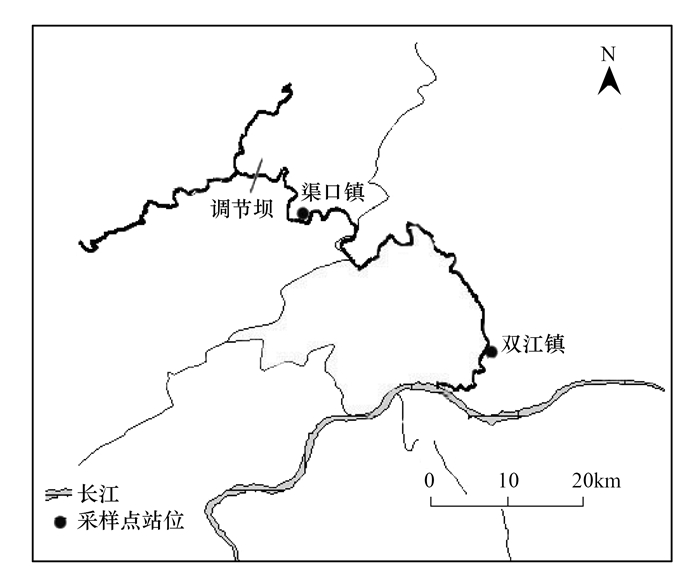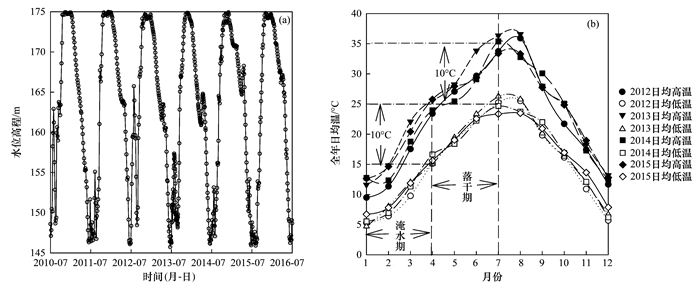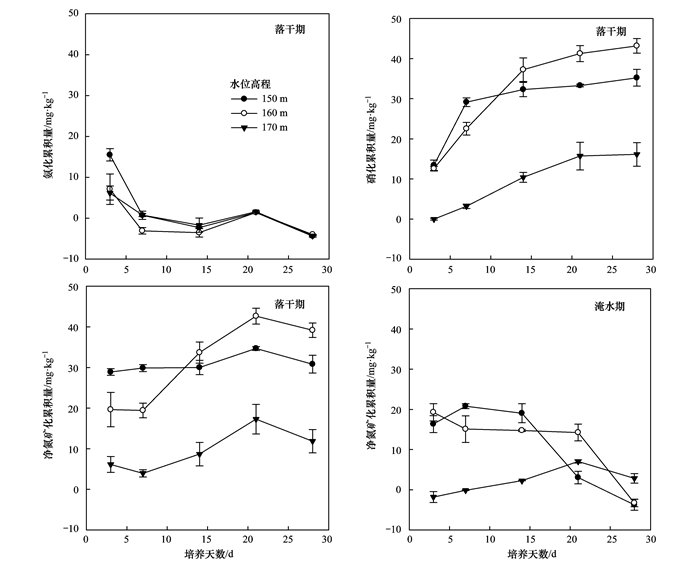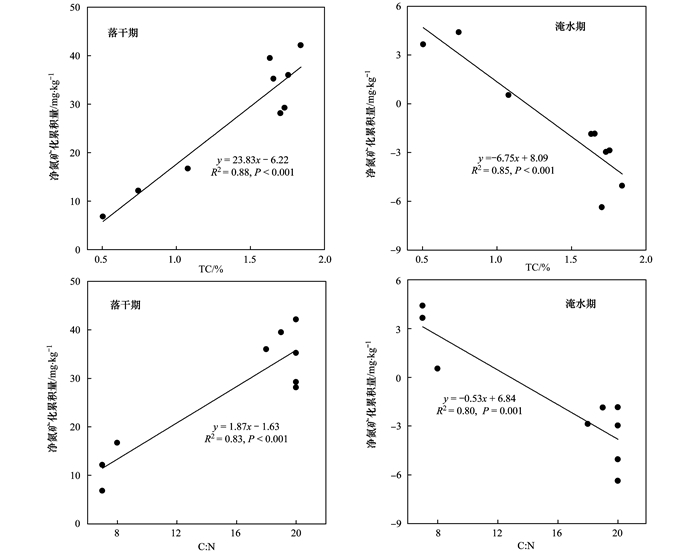2. 重庆三峡职业学院, 农林科技系, 重庆 404100;
3. 南京信息工程大学, 水文气象学院, 南京 210044;
4. 中国科学院重庆绿色智能技术研究院, 中国科学院水库水环境重点实验室, 重庆 400714
2. Department of Agricultural and Forestry Science and Technology, Chongqing Three Gorges Vocation College, Chongqing 404100, China;
3. College of Hydrometeorology, Nanjing University of Information Science and Technology, Nanjing 210044, China;
4. Key Laboratory of Reservoir Aquatic Environment, Chongqing Institute of Green and Intelligent Technology, Chinese Academy of Sciences, Chongqing 400714, China
土壤氮库中99%的氮以有机态形式存在,有机氮在微生物作用下通过氮矿化过程转化为铵态氮(NH4+-N)和硝态氮(NO3--N)等无机氮才可被大部分植物吸收利用[1],而无机氮极易通过淋溶、地表径流、漫滩水位波动和淹水胁迫等作用进入水体,进而增加水体富营养化等潜在风险[2].氮矿化过程是陆地生态系统氮循环的关键环节[3],其主要受土壤pH值[4]、温度和湿度[5]等非生物因子,以及土壤根际过程[6]、土壤微生物[7]、凋落物输入[8]等生物因素的影响.有研究表明,温度升高加速土壤硝化和净氮矿化速率[9, 10].也有研究表明,水分是控制氮矿化的关键因素,土壤净氮矿化速率与水分变化量正相关[11].也有研究认为,温度和水分共同影响土壤氮矿化,且水分的影响更大[12],适宜的温度和湿度有利于土壤氮素长期矿化[13].
三峡库区水位145~175 m之间周期性涨落,淹水-落干过程伴随着季节性温度升高,冬季淹水消落带浸没于水下,而随夏季来临消落带进入落干期并暴露于空气中,使生源要素氧化还原状态[14, 15]和元素周转速率[16~18]等发生明显变化.三峡支流蓄水期水体流速缓慢,氮素进入水体不易稀释扩散,对水生态安全可能带来潜在风险,因此,探讨三峡支流消落带淹水-落干与季节性温度升高耦合过程对土壤氮矿化(氨化作用和硝化作用)的影响对控制三峡支流水体富营养化问题具有重要意义.本文以三峡支流澎溪河消落带沉积物为研究对象,通过淹水落干控温实验,分析淹水-落干和温度升高耦合过程对三峡支流消落带沉积物净氮矿化的影响,旨在为探明三峡支流水体富营养化频发、消落带植被适生性下降等问题提供科学依据.
1 材料与方法 1.1 研究区域与样品采集由于三峡工程特殊的调蓄水制度,使库区水位每年12月上涨至175 m,次年6月消落至145 m,呈年际周期性涨落.本研究于2015年6月,库区水位最低,消落带裸露期间,采样三峡支流澎溪河上游(渠口镇)和下游(双江镇)两个水文断面的150、160和170 m这3个水位高程的沉积物样品(0~5 cm),每个采样点由3个随机样品组成,并将两个断面(图 1)相同高程样品混匀为混合样品用于培养.采集的原状新鲜土样立即充高纯氮(纯度>99.9%)置于保温箱内低温保存,并带回实验室,经冻干、剔除植物根系、过筛后用于氮矿化培养实验,剩余样品用于沉积物基本理化性质的测定.

|
图 1 澎溪河流域采样点站位示意 Fig. 1 Sampling sites in the Pengxi River |
图 2为2011年7月到2016年7月三峡库区万州段水位波动,150 m水位高程淹水时间主要集中在8月~次年6月,160 m水位高程主要淹水时间主要集中在9月~次年4月,170 m水位高程主要淹水时间集中在10月~次年1月,150、160及170 m水位高程的消落带淹水时间平均为338、227和116 d.本研究区气温变化见图 2(b), 由2012~2015全年平均气温统计数据显示,消落带淹水期和落干期无论日均最低温还是最高温均升高约10℃左右.

|
图 2 水位年际涨落及气温变化 Fig. 2 Annual change of water level and temperature |
称取沉积物样品10.0 g于50 mL塑料瓶中,混匀后加去离子水调节含水量至60%最大持水量.为避免厌氧和水分损失,采用parafilm保水透气膜封口,并扎小孔通气.分别于25℃和35℃进行恒温培养,培养期间采用称重法保持水分恒定.分别于培养3、7、14、21、28 d破坏性取样,样品加入100 mL 2mol·L-1的KCl溶液振荡2 h,过滤离心后取上清液测NH4+-N及NO3--N含量.
1.3.2 淹水实验称取沉积物样品10.0 g于50 mL塑料瓶中,缓慢加入20 mL去离子水,所有实验均在手套箱内完成,辅以高纯氮(99.99%)控制在氧气含量小于1×10-6,使培养体系处于厌氧状态.随后拧紧瓶盖,分别置于15℃和25℃的恒温培养箱中进行培养.分别在培养3、7、14、21、28 d用溶液采样器获取沉积物溶液,测定NH4+-N含量(由于厌氧条件无NO3--N产生且培养后期无变化,本实验淹水期氮矿化累积仅用NH4+-N计算).
1.4 测定方法pH值采用0.01 mol·L-1 CaCl2浸提法、铵态氮采用靛酚蓝比色法、硝态氮采用2 mol·L-1 KCl浸提比色法、沉积物粒径采用比重法、总碳(TC)和总氮(TN)用元素分析仪(意大利EA3000).
1.5 计算方法采用文献[19]中氮矿化量的方法,公式如下:

|
(1) |

|
(2) |

|
(3) |
采用上述方法获得净氮矿化量、硝化量和氨化量后,除以对应培养时间i天,得到净氮矿化速率、硝化速率和氨化速率[mg·(kg·d)-1].
通过测定样品在不同培养温度下,相同培养时间土壤氮矿化速率的比值计算其温度敏感性Q10值,公式如下[20]:

|
(4) |
式中,r1、r2分别为培养温度T1、T2时的氮矿化速率[mg·(kg·d)-1].
1.6 统计方法利用Microsoft Excel 2010数据处理,IBM SPSS Statistic 20数据统计,SigmaPlot 12.5进行图形绘制.
2 结果与分析 2.1 消落带沉积物基本理化性质从表 1可见,研究区沉积物总碳含量为(14.37±7.07) g·kg-1,总氮含量为(0.88±0.17) g·kg-1,沉积物NH4+-N含量为(6.77±3.12) mg·kg-1,占总氮的0.77%. NO3--N含量为(37.03±12.41) mg·kg-1,占总氮的4.21%.消落带沉积物NH4+-N含量在水位高程上分布趋势为150 m>160 m>170 m,且150 m与170 m高程之间存在显著性差异(P < 0.05),NO3--N含量在高程上的分布趋势为170 m>160 m>150 m (P < 0.05),总氮含量在150 m和160 m高程显著高于170 m.砂砾在沉积物粒径组成中占比最高(70.57%±8.35%),其次为粉粒(19.62%±6.32%)、黏粒(9.81%±3.13%).
|
|
表 1 消落带沉积物基本理化性质1) Table 1 Physicochemical properties of the sediments in the water level fluctuating zone |
2.2 落干期和淹水期消落带沉积物氮矿化累积量
三峡支流澎溪河消落带沉积物氮矿化累积量(25℃)见图 3.从中可知,落干期氨化累积量随培养时间总体呈下降趋势,但不同水位高程之间无显著变化(P>0.05).相反,硝化累积量随培养时间显著增加(P < 0.05),且在低水位高程(150 m和160 m)显著大于高水位高程(170 m).沉积物净氮矿化累积量在不同水位高程之间均表现为:落干期>淹水期,且在落干期,不同水位高程均表现为随培养时间先升高后下降,而淹水期在低水位高程呈下降趋势,在高水位高程与落干期变化一致.

|
图 3 落干期和淹水期消落带沉积物氮矿化累积量 Fig. 3 N mineralization cumulation of sediment in the water level fluctuating zone during the drying and submerging periods |
三峡支流澎溪河消落带沉积物落干期和淹水期净氮矿化速率变化(25℃)见图 4.从中可知,不同水位高程沉积物氨化速率培养初期(0~7 d)均下降较快,之后无显著变化.而低水位高程(150 m和160 m)沉积物硝化速率随培养时间呈下降趋势,而高水位高程(170 m)沉积物硝化速率无显著变化.落干期和淹水期不同水位高程沉积物净氮矿化速率均随培养时间延长呈下降趋势,低水位高程(150 m和160 m)下降较快,高水位高程(170 m)下降缓慢,且低水位高程净氮矿化速率显著大于高水位高程(P < 0.05).与淹水期相比,落干期沉积物净氮矿化速率更快.

|
图 4 落干期和淹水期消落带沉积物净氮矿化速率 Fig. 4 Net nitrogen mineralization rate of sediment in the water level fluctuating zone during the drying and submerging periods |
三峡支流澎溪河消落带沉积物培养28 d的净氮矿化累积量(25℃)与沉积物C:N、TC含量的线性回归分析见图 5.从中可知,落干期和淹水期沉积物C:N和TC含量变化对氮矿化过程影响显著.落干期沉积物净氮矿化累积量随沉积物TC含量和C:N的增加而显著增加(P < 0.001).而淹水期沉积物净氮矿化累积量变化趋势与落干期相反,随沉积物C:N和TC含量增加而下降(P < 0.001).

|
图 5 净氮矿化累积量与沉积物总碳和碳氮比之间的关系 Fig. 5 Relationships of net mineralized nitrogen with TC and C/N ratio |
沉积物氮矿化的温度系数(Q10)可作为不同基质氮矿化对温度升高响应的敏感系数[20].为探明不同水位高程消落带沉积物净氮矿化速率对温度升高的响应,采用公式(4)计算了净氮矿化速率的温度敏感性Q10,由图 6可知,落干期不同水位高程沉积物净氮矿化速率的温度敏感性(Q10)均大于1,且表现为170 m大于150和160 m.而淹水期150和160 m水位高程沉积物净氮矿化速率Q10小于1,而170 m水位高程Q10大于1.

|
图 6 落干期和淹水期沉积物净氮矿化的温度敏感性 Fig. 6 Temperature sensitivity of net nitrogen mineralization of sediment in drying and submerging periods |
澎溪河消落带沉积物TC、TN、C:N、NH4+-N、NO3--N含量随水位高程变化差异显著(表 1),其中,TC、TN、C:N和NH4+-N随水位高程降低而增加,而NO3--N含量随水位高程降低而降低.可能原因为,一方面,低水位高程淹水胁迫时间较长(150 m, 平均淹水时间338 d),缺氧条件下NH4+-N无法向NO3--N转化,且NH4+-N带正电荷易被沉积物吸附,不易流失,因此NH4+-N累积,浓度呈上升趋势[21].另一方面,高水位高程淹水时间较短(170 m, 平均淹水时间116 d),NH4+-N在落干条件下易通过NH3的形式挥发而损失[22~24].对于沉积物中的NO3--N,因其带负电荷且溶水性使其更易进入水体[25],而低水位高程消落带淹水历时更长[26],因此,通过矿化产生的硝态氮易于进入水体,表现为低水位高程沉积物NO3--N含量更低.另外,高水位高程淹水时间较短,与低水位高程相比,植被适生性相对较好,植被生长茂盛,如狗牙根,高度、密度和单位面积生物量均显著高于150 m和160 m水位高程,这可能与沉积物硝态氮分布有一定的内在联系.可见,落干期有利于消落带植被残体快速降解,淹水后重新进入水体,而高水位高程落干期较长,淹水期较短,低水位与之相反,可能是导致低水位高程的TC、TN和C:N相对较高的重要原因.
落干期沉积物氨化累积量总体呈下降趋势,而硝化累积量呈上升趋势,可能为氨化过程产生的铵态氮作为硝化作用反应底物进一步转化成硝态氮所致(图 3).与低水位高程相比,高水位高程沉积物落干期氮矿化速率更快,氮可利用性更高,在重新淹水后有大量进入水体造成水体富营养化的潜在风险.可见,不同程度的“落干-淹水”循环过程,使消落带沉积物C、N矿化及含量分布存在明显差异.短期培养过程中沉积物氮矿化主要来自易分解氮库,这部分氮库受沉积物团聚体等物理化学保护作用较弱,被优先分解矿化,而沉积物中难分解氮库组分受沉积物团聚体等物理化学保护作用较强,难于分解矿化[28, 29].沉积物硝化速率和氨化速率不同水位高程消落带均表现为培养期间下降较快,后期趋势平缓,而净氮矿化速率在培养前期快速下降受氨化速率的影响较大(图 4).氨化速率和净氮矿化速率在高程上表现为:150 m和160 m高程显著大于170 m高程,可能为低水位高程失去淹水保护后,暴露于空气中,硝化速率相对加快,而高水位高程无明显变化所致.
淹水期净氮矿化累积和矿化速率总体变化趋势一致,表现为培养前期快速下降,后期趋于稳定(图 3和图 4),这与周吉利等[30]的研究结果一致.淹水培养初期,厌氧微生物迅速繁殖并将沉积物中有机氮分解为铵态氮,低水位高程沉积物底物相对充足(比高水位高程C、N和C:N更高)使其氮矿化速率更快.另外,随着培养时间延长厌氧微生物增殖速度减缓,使净氮矿化速率减缓.李建兵等[31]研究表明,盐分累积效应(铵态氮)可能对微生物的生长具有抑制作用,使淹水培养氮矿化速率趋于稳定.沉积物的NH4+利用Fe3+和Al3+等电子受体发生厌氧氨氧化作用转化为N2,使NH4+减少,表现为净氮矿化速率下降.金相灿等[32]研究表明,微生物可能以铵态氮为氮源来合成自身组分,从而使体系中的无机氮转化为有机氮(微生物量氮),使净氮矿化速率下降.淹水胁迫使低水位高程消落带沉积物氮矿化速率降低且对温度升高不敏感(Q10 < 1),对氮素有一定固持作用,但在落干期不同水位高程消落带沉积物氮素均加速矿化且对温度升高更加敏感(Q10>1,图 6),这可能导致氮素在消落带重新淹水加速后大量进入水体,进一步增加三峡支流水体富营养化的风险.
4 结论淹水过程降低了三峡支流消落带沉积物氮矿化速率和低水位高程氮矿化对温度升高的敏感性,而随后的落干过程和季节性温度升高加速了氮矿化过程,从而增加了氮素在淹水重新加湿过程中大量进入水体的风险.可见,淹水-落干循环过程是控制三峡支流沉积物氮素转化和进入水体的关键因素,对解决三峡支流消落带植被适生性下降和落干期水体富营养化频发等问题至关重要,在未来的工作中仍需进一步研究.
| [1] | Schulten H R, Schnitzer M. The chemistry of soil organic nitrogen:a review[J]. Biology and Fertility of Soils, 1997, 26(1) : 1–15. DOI: 10.1007/s003740050335 |
| [2] | Goodridge B M, Melack J M. Temporal evolution and variability of dissolved inorganic nitrogen in beach pore water revealed using radon residence times[J]. Environmental Science & Technology, 2014, 48(24) : 14211–14218. |
| [3] | Mooshammer M, Wanek W, Hämmerle I, et al. Adjustment of microbial nitrogen use efficiency to carbon:nitrogen imbalances regulates soil nitrogen cycling[J]. Nature Communications, 2014, 5 : 3694. |
| [4] | Sun S H, Liu J J, Chang S X. Temperature sensitivity of soil carbon and nitrogen mineralization:impacts of nitrogen species and land use type[J]. Plant and Soil, 2013, 372(1-2) : 597–608. DOI: 10.1007/s11104-013-1758-1 |
| [5] | Guntiñas M E, Leirós M C, Trasar-Cepeda C, et al. Effects of moisture and temperature on net soil nitrogen mineralization:a laboratory study[J]. European Journal of Soil Biology, 2012, 48 : 73–80. DOI: 10.1016/j.ejsobi.2011.07.015 |
| [6] | Zhu B, Gutknecht J L M, Herman D J, et al. Rhizosphere priming effects on soil carbon and nitrogen mineralization[J]. Soil Biology and Biochemistry, 2014, 76 : 183–192. DOI: 10.1016/j.soilbio.2014.04.033 |
| [7] | Abera G, Wolde-Meskel E, Bakken L R. Carbon and nitrogen mineralization dynamics in different soils of the tropics amended with legume residues and contrasting soil moisture contents[J]. Biology and Fertility of Soils, 2012, 48(1) : 51–66. DOI: 10.1007/s00374-011-0607-8 |
| [8] | Mueller K E, Hobbie S E, Oleksyn J, et al. Do evergreen and deciduous trees have different effects on net N mineralization in soil?[J]. Ecology, 2012, 93(6) : 1463–1472. DOI: 10.1890/11-1906.1 |
| [9] | 赵琦齐, 沈玉娟, 李平, 等. 温度对太湖湖滨带不同水分梯度土壤氮矿化的影响[J]. 南京林业大学学报(自然科学版), 2011, 35(6) : 147–150. Zhao Q Q, Shen Y J, Li P, et al. Responses of soil nitrogen mineralization to temperature along soil moisture gradients in the riparian zone of Taihu Lake[J]. Journal of Nanjing Forestry University (Natural Science Edition), 2011, 35(6) : 147–150. |
| [10] | 林俊杰, 张帅, 刘丹, 等. 季节性温度升高对落干期消落带土壤氮矿化影响[J]. 环境科学, 2016, 37(2) : 697–702. Lin J J, Zhang S, Liu D, et al. Effect of seasonal temperature increasing on nitrogen mineralization in soil of the water level fluctuating zone of Three Gorge tributary during the dry period[J]. Environmental Science, 2016, 37(2) : 697–702. |
| [11] | Jin V L, Haney R L, Fay P A, et al. Soil type and moisture regime control microbial C and N mineralization in grassland soils more than atmospheric CO2-induced changes in litter quality[J]. Soil Biology and Biochemistry, 2013, 58 : 172–180. DOI: 10.1016/j.soilbio.2012.11.024 |
| [12] | 李铭, 朱利川, 张全发, 等. 不同土地利用类型对丹江口库区土壤氮矿化的影响[J]. 植物生态学报, 2012, 36(6) : 530–538. Li M, Zhu L C, Zhang Q F, et al. Impacts of different land use types on soil nitrogen mineralization in Danjiangkou Reservoir Area, China[J]. Chinese Journal of Plant Ecology, 2012, 36(6) : 530–538. |
| [13] | 葛晓敏, 王瑞华, 唐罗忠, 等. 不同温湿度条件下杨树人工林土壤氮矿化特征研究[J]. 中国农学通报, 2015, 31(10) : 208–213. Ge X M, Wang R H, Tang L Z, et al. Study on the effects of temperature and moisture on nitrogen mineralization of soil in poplar plantations[J]. Chinese Agricultural Science Bulletin, 2015, 31(10) : 208–213. |
| [14] | 马利民, 张明, 滕衍行, 等. 三峡库区消落区周期性干湿交替环境对土壤磷释放的影响[J]. 环境科学, 2008, 29(4) : 1035–1039. Ma L M, Zhang M, Teng Y H, et al. Characteristics of phosphorous release from soil in periodic alternately waterlogged and drained environments at WFZ of the Three Gorges Reservoir[J]. Environmental Science, 2008, 29(4) : 1035–1039. |
| [15] | 王建超, 朱波, 汪涛, 等. 三峡库区典型消落带草本植物氮磷养分浸泡释放实验[J]. 环境科学, 2012, 33(4) : 1144–1151. Wang J C, Zhu B, Wang T, et al. Nitrogen and phosphorus release from herbaceous vegetation under simulated inundation experiment of water-level fluctuation zone in the Three Gorges Reservior Area[J]. Environmental Science, 2012, 33(4) : 1144–1151. |
| [16] | 胥焘, 王飞, 郭强, 等. 三峡库区香溪河消落带及库岸土壤重金属迁移特征及来源分析[J]. 环境科学, 2014, 35(4) : 1502–1508. Xu T, Wang F, Guo Q, et al. Transfer characteristic and source identification of soil heavy metals from water-level-fluctuating zone along Xiangxi River, Three-Gorges Reservoir Area[J]. Environmental Science, 2014, 35(4) : 1502–1508. |
| [17] | 吉芳英, 王图锦, 胡学斌, 等. 三峡库区消落区水体-沉积物重金属迁移转化特征[J]. 环境科学, 2009, 30(12) : 3481–3487. Ji F Y, Wang T J, Hu X B, et al. Movement and transformation of heavy metals in water-sediment in water-level-fluctuating zone of Three Gorges reservoir area[J]. Environmental Science, 2009, 30(12) : 3481–3487. |
| [18] | Ye C, Li S Y, Zhang Y L, et al. Assessing soil heavy metal pollution in the water-level-fluctuation zone of the Three Gorges Reservoir, China[J]. Journal of Hazardous Materials, 2011, 191(1-3) : 366–372. DOI: 10.1016/j.jhazmat.2011.04.090 |
| [19] | 王士超, 周建斌, 陈竹君, 等. 温度对不同年限日光温室土壤氮素矿化特性的影响[J]. 植物营养与肥料学报, 2015, 21(1) : 121–127. Wang S C, Zhou J B, Chen Z J, et al. Effects of temperature on soil nitrogen mineralization in solar greenhouses with different cultivation years[J]. Journal of Plant Nutrition and Fertilizer, 2015, 21(1) : 121–127. |
| [20] | 高俊琴, 欧阳华, 张锋, 等. 若尔盖高寒湿地土壤氮矿化对温度和湿度的响应[J]. 湿地科学, 2008, 6(2) : 229–234. Gao J Q, Ouyang H, Zhang F, et al. The response of soil nitrogen mineralization to soil temperature and soil moisture in Zoige Alpine Wetland[J]. Wetland Science, 2008, 6(2) : 229–234. |
| [21] | 周涛, 李正魁, 冯露露. 氨氮和硝氮在太湖水华自维持中的不同作用[J]. 中国环境科学, 2013, 33(2) : 305–311. Zhou T, Li Z K, Feng L L. The different roles of ammonium and nitrate in the bloom self-maintenance of Lake Taihu[J]. China Environmental Science, 2013, 33(2) : 305–311. |
| [22] | Berendse F. Implications of increased litter production for plant biodiversity[J]. Trends in Ecology & Evolution, 1999, 14(1) : 4–5. |
| [23] | Evans C A, Miller E K, Friedland A J. Nitrogen mineralization associated with birch and fir under different soil moisture regimes[J]. Canadian Journal of Forest Research, 1998, 28(12) : 1890–1898. DOI: 10.1139/x98-163 |
| [24] | 曹兵, 贺发云, 徐秋明, 等. 南京郊区番茄地中氮肥的气态氮损失[J]. 土壤学报, 2006, 43(1) : 62–68. Cao B, He F Y, Xu Q M, et al. Gaseous losses from n fertilizers applied to a tomato field in Nanjing suburbs[J]. Acta Pedologica Sinica, 2006, 43(1) : 62–68. |
| [25] | Shang F Z, Yang P L, Li Y K, et al. Effects of different chemical nitrogenous fertilizer application rates on soil nitrogen leaching and accumulation in deep vadose zone[J]. Transactions of the Chinese Society of Agricultural Engineering, 2012, 28(7) : 103–110. |
| [26] | Tang Q, Bao Y H, He X B, et al. Sedimentation and associated trace metal enrichment in the riparian zone of the Three Gorges Reservoir, China[J]. Science of the Total Environment, 2014, 479-480 : 258–266. DOI: 10.1016/j.scitotenv.2014.01.122 |
| [27] | Bloom A J. The increasing importance of distinguishing among plant nitrogen sources[J]. Current Opinion in Plant Biology, 2015, 25 : 10–16. DOI: 10.1016/j.pbi.2015.03.002 |
| [28] | Yamashita T, Flessa H, John B, et al. Organic matter in density fractions of water-stable aggregates in silty soils:effect of land use[J]. Soil Biology and Biochemistry, 2006, 38(11) : 3222–3234. DOI: 10.1016/j.soilbio.2006.04.013 |
| [29] | 于维水, 卢昌艾, 李桂花, 等. 不同施肥制度下中国东部典型土壤易分解与耐分解氮的组分特征[J]. 中国农业科学, 2015, 48(15) : 3005–3014. Yu W S, Lu C A, Li G H, et al. Component characteristics of soil labile and recalcitrant nitrogen under different long-term fertilization systems in east China[J]. Scientia Agricultura Sinica, 2015, 48(15) : 3005–3014. |
| [30] | 周吉利, 邹刚华, 彭佩钦, 等. 中亚热带典型红壤区土壤氮矿化动力学参数估算[J]. 农业现代化研究, 2015, 36(4) : 702–707. Zhou J L, Zou G H, Peng P Q, et al. Estimating the kinetic parameters of soil organic nitrogen mineralization for various land use types in a typical hilly red-soil region in subtropical central China[J]. Research of Agricultural Modernization, 2015, 36(4) : 702–707. |
| [31] | 李建兵, 黄冠华. 盐分对粉壤土氮转化的影响[J]. 环境科学研究, 2008, 21(5) : 98–103. Li J B, Huang G H. Pilot study of salinity (NaCl) affecting nitrogen transformation in silt loam soil[J]. Research of Environmental Sciences, 2008, 21(5) : 98–103. |
| [32] | 金相灿, 崔哲, 王圣瑞. 连续淹水培养条件下沉积物和土壤的氮素矿化过程[J]. 土壤通报, 2006, 37(5) : 909–915. Jin X C, Cui Z, Wang S R. Nitrogen mineralization processes of sediments and soil under continuously waterlogged incubation conditions[J]. Chinese Journal of Soil Science, 2006, 37(5) : 909–915. |
 2017, Vol. 38
2017, Vol. 38

